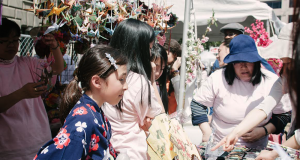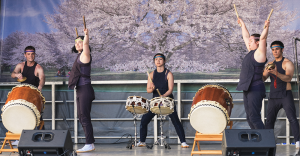
Sakura Matsuri draws thousands to its street festival attempting to display Japanese culture. While it is the biggest Japanese cultural events of its type, only around a tenth of visitors are of Japanese origin.
The cherry blossoms are forecasted to be at their peak this weekend, just in time to splash Washington, D.C., with a burst of color for the National Cherry Blossom Festival. Sakura Matsuri, the grand finale of the event, is set to be a spectacular one-day celebration.
Held right after the National Cherry Blossom Festival Parade this Saturday from 10 a.m. to noon, Sakura Matsuri is a street festival dedicated to showcasing Japanese culture through performances, food and vendors. From perennial favorites like the culinary showcase “Taste of Japan” to newly introduced initiatives like the “Experience Japan through Education” pavilion, Sakura Matsuri promises to bring decades of Japanese-American cultural exchange and friendship to new heights this year.
In Japan, “Sakura” refers to cherry trees in bloom. Seamlessly blending traditional and modern Japan, the festival offers something for everyone and anyone who has even the slightest interest in any aspect of Japanese culture, from “taiko” drumming to J-pop performances to sake-making.
Interest in Japan and Japanese culture is at an all-time high. As the largest Japanese cultural festival of its kind in the United States, Sakura Matsuri draws about 40,000 visitors annually, of which only about 10 percent are visitors of Japanese origin or descent, according to Mark Hitzig, Executive Director of the Japan-America Society of Washington D.C. — the sponsor and organizer of the festival.
“About 80 to 90 percent of the people who come have an interest in Japan — they’ve been to Japan, or they want to go to Japan … you have all these people interested in Japanese culture, and they all have a different reason [why],” Hitzig said.
This, he says, differentiates Sakura Matsuri from other similar cultural festivals in the area, where most of the participants are of that particular ethnic or cultural origin.
In its 55th year, Sakura Matsuri has blossomed from being a small festival held at Freedom Plaza to a large-scale national event spanning Pennsylvania Avenue from ninth Street to 14th Street for a full 980 by 930 feet. Amazingly, the JASW office in charge of running the entire event has remained the same size throughout the years, with three to four full-time workers and only two of those working on Sakura Matsuri. Thus, it requires a massive mobilization of temporary staff and volunteers to workto ensure that the festival is organized and executed smoothly.
One of these volunteers is Arisa Ishita, a second-year Georgetown graduate student who works as the public relations coordinator for Sakura Matsuri.
“Although it can be tough and time consuming, I really like working here and being a part of this organization,” she said. Such is the passion and drive among Ishita and her fellow volunteers working to ensure that the festival is a success.

Sakura Matsuri takes place every year alongside the Cherry Blossom Festival. The one-day event offers a plethora of Japanese cultural activities, including cooking, music and education.
As a result of the organizing committee’s work, visitors to Sakura Matsuri this year can anticipate even more varied and interesting ways to experience Japanese culture.
The festival is hosting a number of performers specializing in many different types of Japanese music and art. Fans of J-pop can look forward to seeing acts like HIDEKING project, while those more inclined toward the traditional can enjoy the drumming of Bonten, a Japanese drumming troupe, or even the shamisen duo HAZUKI. Beloved animation characters like Doraemon and DOMO-kun will also be making their appearances at the festival.
Of course, one cannot forget Japan’s cuisine — arguably one of its most known exports. Awarded United Nations Educational, Scientific and Cultural Organization (recognition as an addition to the Lists of Intangible Cultural Heritage in 2013, the sheer number of Japanese eateries around the city attests to its popularity in America. Sakura Matsuri’s “Taste of Japan” showcase will offer samples of over 25 Japanese restaurants. In addition, the Culinary Arts Pavilion will feature renowned Japanese chefs like Chef Tatsuo Saito, who will demonstrate how to cook Japanese food throughout the day. To wash all that food down, those of age can also look forward to the Kirin Beer Gardens and the Hakutsuru Sake Tasting Pavilion.
What may be of particular interest to Georgetown students is the new Experience Japan through Education Pavilion being introduced this year. Other than the long-running Japan Exchange and Teaching Program, three universities — Waseda University, Temple University (Japan Campus) and International Christian University — will be participating in the pavilion to share with visitors the different ways of experiencing Japan through studying or teaching there.
With all the buzz surrounding Sakura Matsuri, the cherry blossoms must not be overlooked. Besides looking beautiful, the cherry blossom trees are significant in representing the lasting Japanese-American friendship. The first cherry blossoms to appear in Washington, D.C. were donated by a Japanese ambassador in 1912, and the annual celebration of the cherry blossoms honors the continued cooperation between the two countries.
“To learn about your culture, you have to teach it to others,” Hitzig said. Citing his own personal experiences teaching English in Japan through JET, he said he learned more about American culture his year abroad than he ever had in prior years living in America.
In all, Sakura Matsuri is not just a street festival designed purely for entertainment and springtime frivolities.
“Our goal is to educate people about Japan and the Japanese-American relationship, so one way of doing it is through outreach, the biggest of which is this festival,” Hitzig said.
The spirit of cultural exchange and mutual understanding between Japan and America is captured in the microcosm that is Sakura Matsuri and, by extension, the National Cherry Blossom Festival. Although Sakura Matsuri lasts less than a day, its missions and goals in educating and edifying its visitors are worthy ones. Of course, if one is interested in engaging with Japanese culture at a deeper level after visiting Sakura Matsuri, the JASW is a good resource with which to start.
Admission for Sakura Matsuri is $10 for visitors aged 13 and above. Tickets can be purchased on the day of the festival or in advance online at www.sakuramatsuri.org.


















